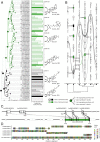A co-opted steroid synthesis gene, maintained in sorghum but not maize, is associated with a divergence in leaf wax chemistry
- PMID: 33723068
- PMCID: PMC8000359
- DOI: 10.1073/pnas.2022982118
A co-opted steroid synthesis gene, maintained in sorghum but not maize, is associated with a divergence in leaf wax chemistry
Abstract
Virtually all land plants are coated in a cuticle, a waxy polyester that prevents nonstomatal water loss and is important for heat and drought tolerance. Here, we describe a likely genetic basis for a divergence in cuticular wax chemistry between Sorghum bicolor, a drought tolerant crop widely cultivated in hot climates, and its close relative Zea mays (maize). Combining chemical analyses, heterologous expression, and comparative genomics, we reveal that: 1) sorghum and maize leaf waxes are similar at the juvenile stage but, after the juvenile-to-adult transition, sorghum leaf waxes are rich in triterpenoids that are absent from maize; 2) biosynthesis of the majority of sorghum leaf triterpenoids is mediated by a gene that maize and sorghum both inherited from a common ancestor but that is only functionally maintained in sorghum; and 3) sorghum leaf triterpenoids accumulate in a spatial pattern that was previously shown to strengthen the cuticle and decrease water loss at high temperatures. These findings uncover the possibility for resurrection of a cuticular triterpenoid-synthesizing gene in maize that could create a more heat-tolerant water barrier on the plant's leaf surfaces. They also provide a fundamental understanding of sorghum leaf waxes that will inform efforts to divert surface carbon to intracellular storage for bioenergy and bioproduct innovations.
Keywords: cuticular wax; drought tolerance; juvenile-to-adult transition; sorghum bicolor; triterpenoids.
Copyright © 2021 the Author(s). Published by PNAS.
Conflict of interest statement
The authors declare no competing interest.
Figures






References
-
- Alexandratos N., Bruinsma J., “World agriculture towards 2030/2050, the 2012 revision” (2012).
-
- Foley J. A., et al. ., Solutions for a cultivated planet. Nature 478, 337–342 (2011). - PubMed
-
- Winchell F., Stevens C. J., Murphy C., Champion L., Fuller D., Evidence for sorghum domestication in fourth millennium BC Eastern Sudan: Spikelet morphology from Ceramic impressions of the Butana group. Curr. Anthropol. 58, 673–683 (2017).
-
- Wet J. M. J. D., Harlan J. R., The origin and domestication of Sorghum bicolor. Econ. Bot. 25, 128–135 (1971).
Publication types
MeSH terms
Substances
LinkOut - more resources
Full Text Sources
Other Literature Sources

